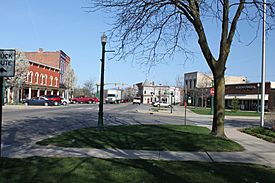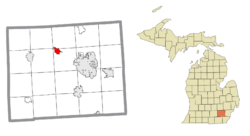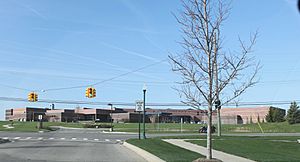Dexter, Michigan facts for kids
Quick facts for kids
Dexter, Michigan
|
|
|---|---|

Downtown Dexter along Ann Arbor Street
|
|

Location within Washtenaw County
|
|
| Country | United States |
| State | Michigan |
| County | Washtenaw |
| Settled | 1824 |
| Incorporated | 1830 (village) 2014 (city) |
| Government | |
| • Type | Council–manager |
| Area | |
| • Total | 1.97 sq mi (5.09 km2) |
| • Land | 1.94 sq mi (5.03 km2) |
| • Water | 0.02 sq mi (0.06 km2) |
| Elevation | 869 ft (265 m) |
| Population
(2020)
|
|
| • Total | 4,500 |
| • Density | 3,399.0/sq mi (1,315.5/km2) |
| Time zone | UTC-5 (Eastern (EST)) |
| • Summer (DST) | UTC-4 (EDT) |
| ZIP code(s) |
48130
|
| Area code(s) | 734 |
| FIPS code | 26-22160 |
| GNIS feature ID | 0624624 |
Dexter is a city located in Washtenaw County, Michigan, in the United States. In 2020, about 4,500 people lived there.
Dexter started as a village in 1830. It officially became a city on November 20, 2014.
Contents
History of Dexter
In 1966, something strange happened in Dexter. A local truck driver named Frank Mannor saw a glowing object near his home. An astronomer named J. Allen Hynek came to investigate. He said the sighting was probably caused by "swamp gas." This term became famous for explaining UFO sightings. Because of this, Gerald R. Ford, who was a Congressman from Michigan and later became president, asked for a government investigation into the UFO reports in southern Michigan.
On March 15, 2012, a strong tornado hit Dexter. It was an EF3 tornado, which means it was quite powerful. It caused a lot of damage to homes and businesses. Luckily, no one was hurt.
Later, on November 4, 2014, the people of Dexter voted to change their town from a village into a city.
Geography and Nature
Dexter covers about 1.97 square miles (5.09 square kilometers). Most of this area is land, with a small part being water.
The city is located along the Huron River. You can find parts of two large parks nearby: Hudson Mills Metropark and Dexter–Huron Metropark. The Border-to-Border Trail, a path for walking and biking, also goes through Dexter.
Getting Around Dexter
The WAVE Community Connector Bus helps people travel around Dexter. It also connects Dexter to nearby towns like Chelsea and Ann Arbor. In Ann Arbor, you can switch to other buses.
The Border-to-Border Trail in Washtenaw County connects downtown Dexter to Hudson Mills Metropark. There's also a trail being built to connect to Dexter-Huron Metropark.
Dexter has an old train station built around 1840. Back then, it was the end of the Central Railroad of Michigan line from Detroit. Today, no trains stop there. Instead, it's home to the Ann Arbor Model Railroad Club. You can see old railroad items like crossing signals and baggage carts around it.
The main streets in downtown Dexter used to have simple names like A, B, C, D, and E Streets. Now, they are called Alpine, Broad, Central, Dover, and Edison Streets.
People of Dexter
In 2020, Dexter had a population of 4,500 people. There were 2,466 households. Most homes (96%) are owned by the people who live in them.
Most people in Dexter are White (93.2%). There are also people of Asian (1.5%), African American (0.3%), and other backgrounds. About 3.6% of the population is Hispanic or Latino.
About 26% of residents are under 18 years old, and 19% are 64 or older. Almost everyone (100%) in Dexter has graduated from high school, and more than half (54.5%) have a college degree or higher.
The average income for a household in Dexter is about $125,128 per year.
Arts and Entertainment
The Encore Musical Theatre Company was started in Dexter in 2008. It's a non-profit theater that puts on musical shows. They use a mix of professional actors from Broadway and local talent. In 2020, they bought a new building and started having outdoor performances during the COVID-19 pandemic.
News and Media
Dexter has a few local newspapers. The Dexter Leader and the Sun Times News cover local events. The Ann Arbor News also reports on Dexter.
The Community Observer is a free magazine delivered to homes in Dexter. It covers events in Dexter and nearby towns.
Students at Dexter High School publish their own newspaper called The Squall. It has won several national awards for high school journalism.
Schools in Dexter
Dexter Community Schools is the public school district for Dexter. It includes:
- Beacon Elementary School (Kindergarten to 2nd grade)
- Anchor Elementary School (Kindergarten to 2nd grade)
- Wylie Elementary School (3rd to 4th grade)
- Creekside Intermediate School (5th to 6th grade)
- Mill Creek Middle School (7th to 8th grade)
- Dexter High School
Dexter High School is considered one of the top high schools in Michigan. Since 2012, the high school has offered the International Baccalaureate Diploma Programme, which is a challenging program for students.
There are also some private and community-run schools nearby, like Daycroft Montessori and Honey Creek Community School. The Dexter Cooperative Nursery School is a local preschool.
Sports and Clubs
Dexter is known for its high school boys' cross country team. They tied a state record by winning five state championships in a row from 2002 to 2006!
Since 2011, Dexter has had a vintage base ball team called the Union Base Ball Club of Dexter. They play baseball using old rules from the past.
The Dexter Ringers Horseshoe Club started in 1978. It's a club for playing horseshoes competitively. They play every summer at First Street Park, which has twelve horseshoe pits.
The Dexter Baseball Club was formed in 2003. It later became the Dexter Little League (DLL). Each year, 400 to 500 boys and girls aged 6 to 14 play on more than 40 baseball and softball teams.
Famous People from Dexter
- Benny Frey: A professional baseball player who pitched for the Cincinnati Reds.
- Arthur Hills: A famous designer of golf courses.
- Harrison Jeffords: A colonel in the Union Army during the Civil War and a hero at the Battle of Gettysburg.
- Rob Malda: Known for supporting open-source software and starting the website Slashdot.
Images for kids
See also
 In Spanish: Dexter (Míchigan) para niños
In Spanish: Dexter (Míchigan) para niños







